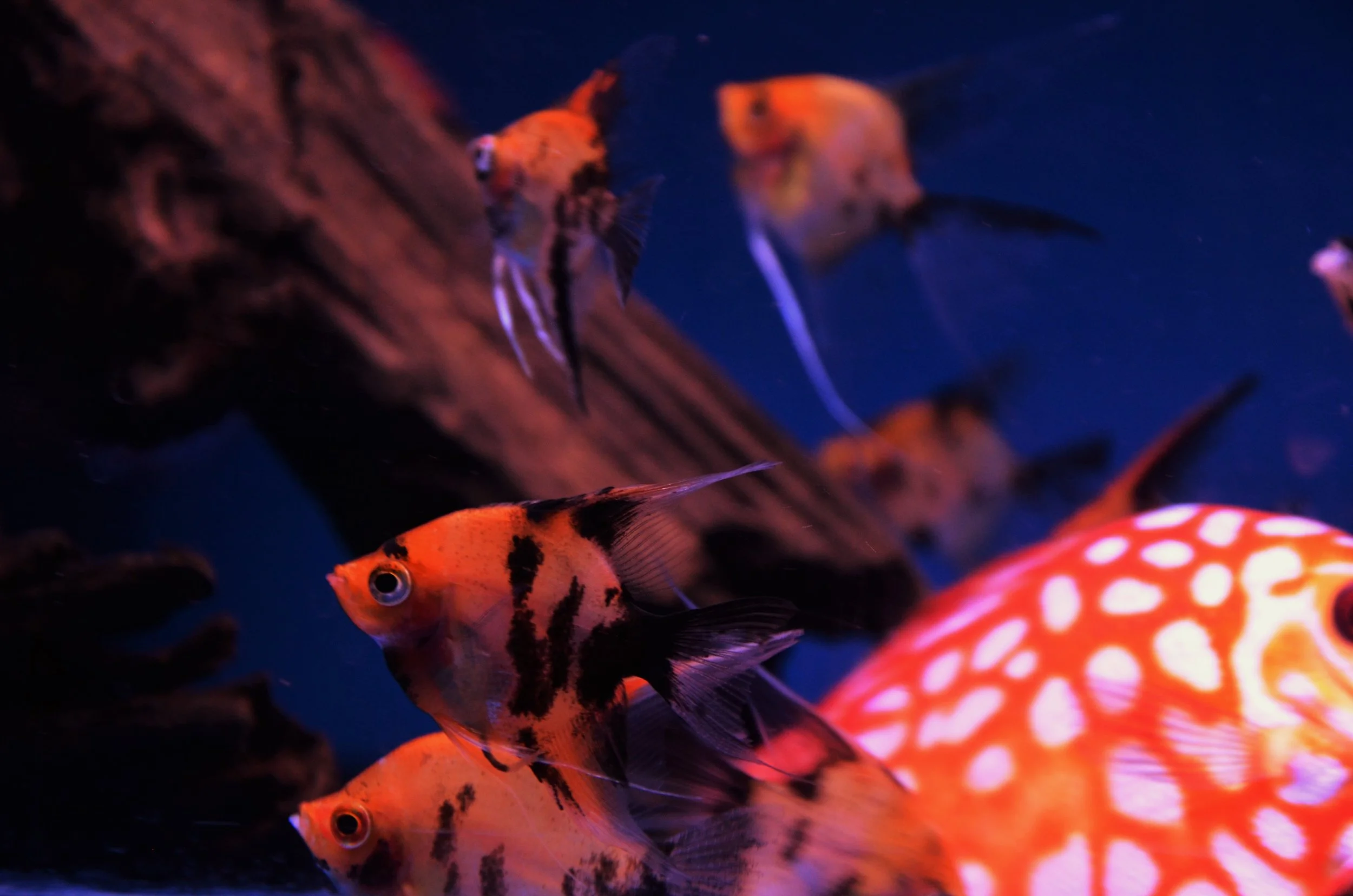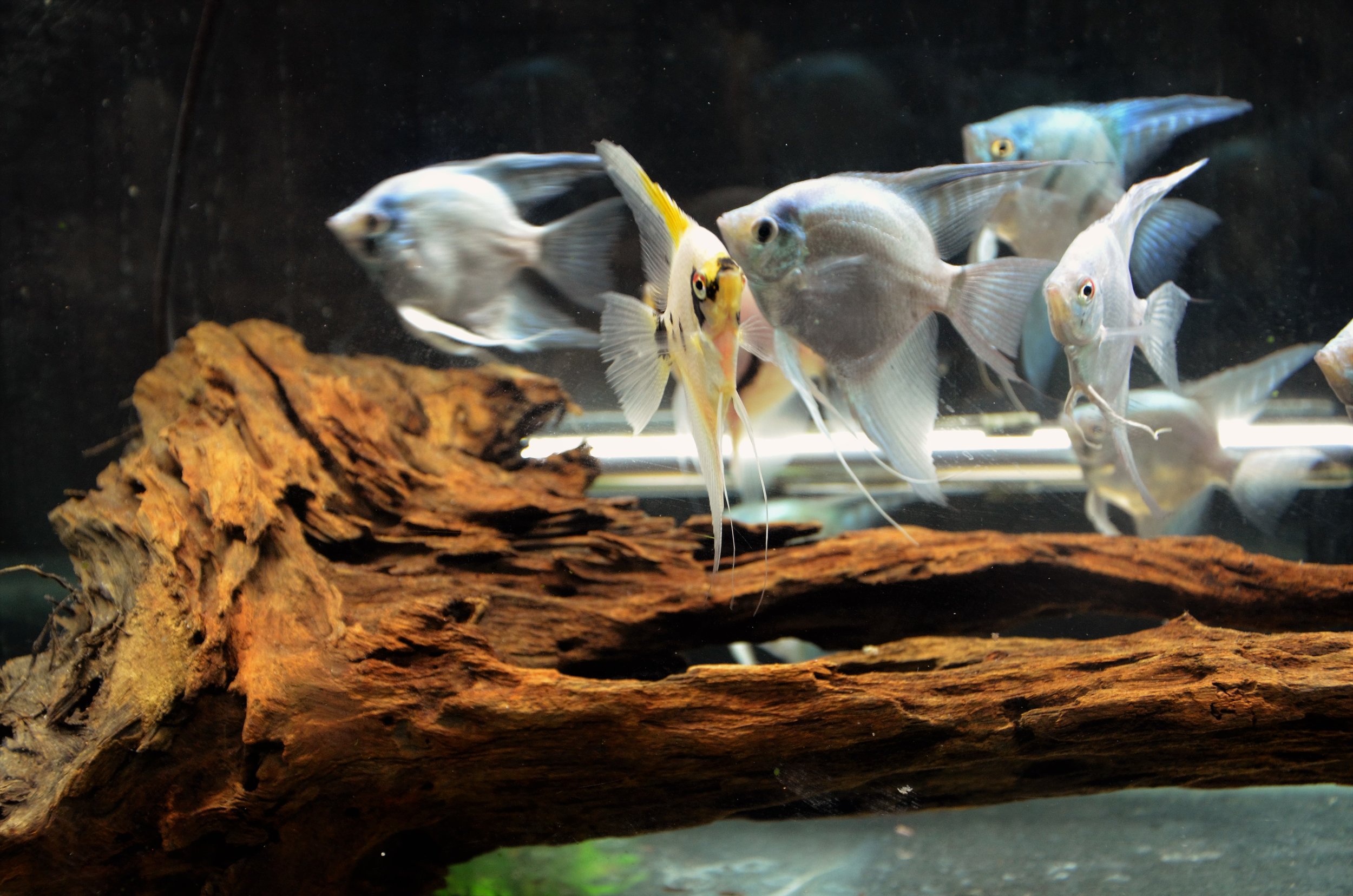ANGELFISH ANATOMY
ANGELFISH CARE
Aquarium Size:
Providing an adequate amount of space is vital for the proper growth and development of your Angelfish. With this in mind the size of the aquarium itself is less of a factor than the critical ratio of angelfish per gallon. The size of the angelfish as well as a host of other environmental variables are instrumental in determining how much space your angelfish will need to thrive. Some of the variables include pH, temperature, feeding practices, water changing volume, water changing frequency, strain of angelfish being kept and the overall quality of angelfish you desire to raise or maintain. The following is a general guideline for the fish size to space ratio that is conducive to health in angelfish.
- Nickel size bodies - 1 angelfish per gallon
- Quarter size bodies - 1 angelfish per 2 gallons
- Silver dollar size bodies - 1 angelfish per 3 gallons
- Adult ready to be paired - 1 angelfish per 5 gallons
- Full grown breeding pair - 20 gallon tall
Super Veil Blue Silver Cross Angelfish
Aquarium Filter:
There are a number of easily obtainable quality filtration systems. The form that angelfish bodies are configured in is not ideal for persistent heavy swimming, as such gentle or low flow aquarium filtration is preferable. Heavy water movement in the aquarium will cause stress and decrease the rate of growth due to the energy expended by having to swim against a heavy current or water flow. Sponge filters are a good option best suited for fish hatcheries, where expense is a concern. Another option that is commonly used for show tanks or display tanks is the under-gravel filters, as the filtration apparatus does not overwhelm the decor or the specimens. For a more densely populated tank, a whole-tank filter has proven an adequate option. Another viable filtration option is a fluidized bed filter, this option has both internal and external filtration systems depending on size of aquarium. The overriding factor that the aquarium enthusiast must take into consideration is simply that the factor that will limit the carrying capacity of angelfish is not biological filtration but rather the level of dissolved organics and potential bacterial loads that can occur as a result of crowded aquariums, overfeeding or insufficient percentage of water changed from the aquarium. In general the most efficient way to reduce the level of dissolved organic and bacterial levels is to do frequent and sufficient water changes on the aquarium or aquariums. What is sufficient will largely depend on how densely populated the tank is along with how much is fed and what kind of filtration is used in the aquarium.
Aquarium Temperature:
Angelfish are able to tolerate a range of aquarium temperatures, however, their immune system responds best to higher temperatures. Based on the conditions of the aquarium, you will have more problems at lower temperatures. An ideal standard temperature for a hatchery would be 80° F at this temperature it can be reasonably well assured that all of the fish of varying sizes will be kept at a good standard of health. The life-span of Angelfish (being a cold blooded species) will be extended if kept at a lower temperature. Angelfish will remain in good health at temperature range of mid to upper seventies. Higher temperatures of the low eighties will insure faster growth, more frequent breeding, better immune system response but shorter life spans. Therefore, it is a delicate balance where certain angels may be kept at higher temperatures allowing their productivity in breeding and rapidity of growth but keeping certain show specimens at a lower temperature to ensure a lengthened life span.
Feeding Angelfish:
The amount of food that is introduced into an aquarium will vary based on a number of factors. The variables that need to be taken into consideration will derive from the population density of the aquarium, the size of the angelfish, and crucially the water conditions of the aquarium. Observation of the angelfish and the aquarium is crucial when feeding, and while it is preferable to underfeed slightly than to overfeed, this is where observation becomes vital as the amount of food introduced can be modified based on what goes uneaten or whether a greater amount of food needs to be introduced to ensure that all the angelfish are able to receive adequate nourishment. The amount that is fed will change as the angelfish grow, and as water parameters change, temperature, pH, water hardness etc., As a very general rule the growing angelfish can be fed more frequently than the adult angelfish but this is subject to the amount of maintenance that is willing to be done on the aquarium, if the maintenance is less than adequate and angelfish are overfed their environment can quickly become polluted. A variety of high quality foods can be fed. When raising angelfish it is necessary to feed live food while the angelfish are in the fry stage, baby brine shrimp can be hatched and fed during the fry stage of angelfish development, micro-worms grown from a culture can be fed at this stage as well. These live micro-foods should be fed exclusively for approximately the first four to six weeks of the angelfish free swimming. After this new foods can be introduced progressively as the angelfish develop. Quality flake foods can begin to be fed provided that they are crumbled into very small pieces before being fed to the small angelfish. New foods should be introduced gradually keeping in mind that the angelfish will take the food more readily when they are hungry, as a result a new food is best introduced on the first feeding of the day than a later feeding. As the angelfish develop new foods can be introduced to provide a diverse diet among these are frozen brine shrimp, frozen blood-worms, frozen beef heart, and some angelfish keepers elect to make their own foods which can be done either through processing a beef-heart paste or cultivating worms from a culture.
ANGELFISH HEALTH
In order the promote the integrity of Angelfish strains it is vital not to allow the propagation of flawed specimens. The culling process removes angelfish that are not ideal, so that the defective elements in those angelfish are not passed on to their progeny. Improper breeding has over the years introduced many defects into angelfish strains. Degradation of angelfish strains can result rapidly if the breeder is not vigilant in eliminating flawed angelfish. Spawns from adult angelfish that have defects or flaws should not be kept, those flaws will likely be perpetuated in their offspring. The propagation of genetically flawed angelfish does a disservice to the species and the hobby.
Another crucial element of ensuring the health of Angelfish is to incorporate a process of quarantine for all foreign specimens (including fish, plants, and other aquatic animals) that are introduced into your aquarium or fish-room. Angelfish can be afflicted by viruses, bacteria and parasites, many of which effect only these particular South-American cichlids. Furthermore, the appearance of the angelfish can be excellent when viewed before or even after purchase but there may be serious underlying health issues. These issues have been known to result in death within a day or two or lead to persistent health problems. Among hobbyists and even professional commercial breeding operations there are a plethora of horror stories where entire facilities become afflicted with virulent diseases and entire fish-rooms effectively wiped out. The only real way to avoid this possibility is to completely quarantine all fish, plants and aquatic animal that is to be introduced from an outside source. A healthy aquarium can be infected with a microscopic drop of water from the contaminated aquarium. Ideally quarantine aquariums would be in a separate room or a different building, all items used (net, siphon, water bucket, etc.) in the quarantine space should never be brought into the fish-room or by the aquarium. Quarantine periods may differ but should last for several weeks to be effective and if fish appear healthy after a few weeks, the only real way to know whether the fish are free of any infectious diseases, parasites etc., is to examine with a microscope or to introduce a fish from a healthy tank into the quarantine aquarium and observe for a couple of weeks to see if the introduced fish becomes infected. While it would be a shame to lose one of your fish especially if you don't have any fish you consider dispensable but it would be far worse to lose an entire aquarium. If the fish introduced into the quarantine tank appears healthy after a couple of weeks it is likely safe to introduce the quarantine fish into your regular aquarium. Vigorous observation should be exercised before introducing to regular non-quarantine aquarium. Also it should be kept in mind that these South-American cichlids can be infected with diseases that remain dormant for lengths of time before manifesting themselves with physical symptoms; with this in mind it is ideal to purchase fish from trusted sources or sources with a history of providing healthy fish.




